Voucher period for privatization in Russia in the 1990s. was her first chord. This stage is also called “national”, as thanks to checks in the country there were about 40 million shareholders. The voucher model was full of contradictions and legal flaws that led to an uneven redistribution of property in the country.
Goals
In 1992 - 1994 voucher privatization was carried out in Russia. Ideologists of economic reforms, she was seen as the first stage of the transfer of state property to private hands. The forms, goals, options and specific ways of privatization were defined in special documents. These were state programs adopted in 1992 and 1993.
They proclaimed the main goals of privatization. They came down to the formation of a layer of private owners, which were supposed to help the authorities create a market economy. It was believed that voucher privatization would help increase the efficiency of enterprises. The funds received from the hands of citizens to the treasury were planned to be spent on the development of social infrastructure. All of the above should contribute to the process of stabilizing the economic situation in the Russian Federation. In addition, voucher privatization could attract foreign investment, help demonopolize the country's economy and create a competitive environment.
According to the program, state property was divided into several groups. These were enterprises whose voucher privatization was prohibited, objects that were privatized according to the decision of the Russian government. The other category included plants subject to immediate and compulsory privatization.

Vouchers
The government has provided four privatization method with the help of which state-owned enterprises were to be privately owned: commercial tender, auction, lease with option to purchase and corporatization. The latter method was associated with vouchers. According to the new legislation, every citizen of the Russian Federation acquired a personal account. He credited the money that paid for the privatization of state enterprises.
The privatization check, or voucher, began to be used in Russia in early 1992. It was these government securities that were accepted as payment for a share in privatized property. According to the law, every Russian citizen had the right to receive only one voucher. These securities had a limited validity period (3 years from the date of issue). Each privatization check had face value equal to 10 thousand non-dominated rubles. Moreover, the sale and purchase of these securities was declared free, and their real price was determined by agreement of the parties to the transaction. On the eve of privatization, the aggregate of the country's enterprises was estimated at 1.400 billion rubles. The number of vouchers issued was determined based on this figure.
disadvantages
From its very beginning, privatization in Russia has become controversial. Its format was vague and had many legal holes. In addition, although some countries already had experience of privatization after the collapse of a planned and centralized economy, its scale as in Russia has never happened before. The government and the Supreme Council for a long time could not agree on how state enterprises will be transferred to private hands. In addition, lobbying groups sought to protect the interests of certain businessmen and large owners influenced the sales format.
The essence of the voucher privatization did not like the main ideologists of building a market economy - Yegor Gaidar and Anatoly Chubais. Nevertheless, on July 3, 1991, the law on the use of registered accounts was nevertheless adopted. Voucher privatization in Russia has acquired many shortcomings, the most significant of which is the vulnerability to corruption. Employees of the enterprises had pre-emptive rights to repurchase shares. Experience has shown that “red directors” often pressured employees by buying their checks and taking control of large property. They could also achieve the necessary voting results during the meeting of shareholders of the labor collective.
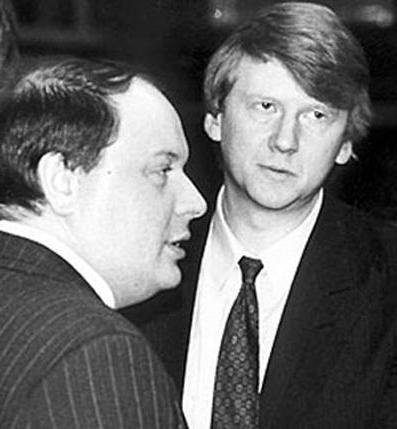
Privatization progress
All stages of privatization in large and medium enterprises fit in two steps. The first was the corporatization of a plant or factory and transformation into new open joint stock companies. The organizational and legal form of the enterprise changed radically. After that there was a release of shares distributed between its employees according to their vouchers. These were members of the workforce and leadership. Also, part of the shares could fall into the hands of external legal entities and individuals. The proportions of this distribution were determined by the workers themselves. In some cases, a certain block of shares remained in municipal or state ownership. If this happened, then representatives of the Russian Federation or its subjects were appointed to such societies.
In each specific case, labor collectives decided in their own way what to do with the property - to separate individual enterprises from its structure or to combine them into groups, thus creating large companies. They became holdings and owned a controlling stake. It was believed that it was the workers who would best decide the fate of their enterprises. They were interested persons (in economic theory there is a similar concept - “stakeholders”), and they were not just detached indifferent observers who saw only property in the plant. Nevertheless, effective entrepreneurs from ordinary workers did not work. Affected by the inappropriateness of the masses to the new market conditions.
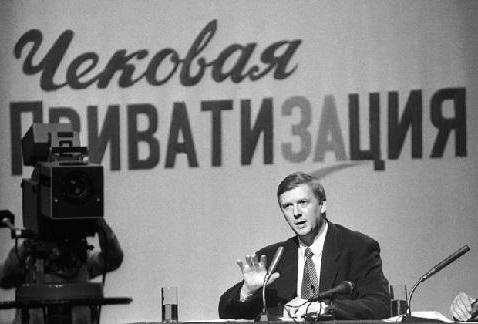
"Popular privatization"
In 1992 - 1994 about 40 million people in Russia became shareholders, and another million became small businessmen. Therefore, the concept of “popular privatization” has become established in everyday life. This is usually called the very first period of redistribution of property in Russia in the 1990s.
Gratis distribution of vouchers was effective only in the first months of reform. Soon, the impossibility of assessing the real market value of these securities became clear. Affected by the underdevelopment of market relations and the embryonic state of the stock market. The cost of one voucher could range from a few rubles to thousands of rubles, depending on the particular enterprise and context.
Criminalization
Ordinary shareholders were almost unable to manage the affairs of the joint-stock company, even though formally the property was distributed evenly. In addition, in 1992 a revaluation of the capital of all privatized enterprises was carried out. The flaw was that it was carried out without inflation. Thus, the property received an underestimated value, which only facilitated its transfer to the hands of the “red directors” and other managers who realized their own privileged position in time.
In fact, due to the lack of thought in the mechanism for applying and issuing vouchers, different groups of people found themselves at unequal starting positions in the race for privatized property. Very quickly, this led to the criminalization of economic relations. For example, secret and illegal transfers of blocks of shares to various influential officials became frequent, although they did not have the right to participate in the purchase of securities.
With the widespread scale of privatization, the state hardly benefited from it.In 1993, income from commercial use municipal enterprises amounted to less than a percent of all treasury income. The expected foreign investment never came. Foreign businessmen were afraid to carry money to a market where "wild capitalism" reigned, crime reigned, and the law was powerless.

results
In total, during the privatization period, about 16 thousand enterprises were sold for privatization checks. By mid-1994, as a result of voucher transactions, 70% of the country's industry was privately owned. Most of the small privatization facilities were also transferred. This category included 85 thousand shops, cafes, restaurants, etc. Small privatization in most regions of Russia ended by the end of 1994. By the same time, about 20 thousand joint-stock companies were created on the basis of large and medium enterprises.
The state provided several options for benefits to labor collectives. Most of them (75%) preferred to choose a controlling stake. It was believed that this form of ownership would help to avoid the establishment of external extraneous control over enterprises. Nevertheless, the advantages of this option quickly came to naught, due to the fact that the shares were bought up by the administration. About a third of all vouchers were resold for nothing using check investment funds (CHIF). They made deals with 22 million citizens (about 15% of the Russian population). The vouchers made to the CHIF practically did not give any dividends because these short-term organizations quickly ceased to exist. Therefore, as a rule, employees became shareholders only for a short period. In addition, the possession of a single paper anywhere and never made a person a real co-owner of the enterprise.
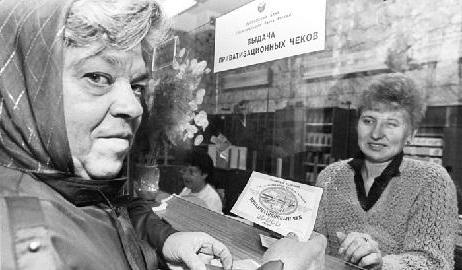
The end of the privatization voucher period
The main result of voucher privatization was the transition from a command and administrative economy to a market model. The state has lost monopoly in most areas National economy. The large-scale process lasted only two years. Such a surprise could not do without shocks. No wonder the reforms of the early 90s are still called "shock therapy." Vouchers have proven to be an effective means of destroying a pre-existing economic and social system. The destruction of the old foundations could not be accompanied by economic growth.
When the voucher phase of privatization ended, private owners appeared in the country, but almost none of them could be attributed to responsible and efficient entrepreneurs. New owners who bought up companies for nothing could come “from the side”, having no idea about the realities of the industry. Often, entrepreneurs only cared about making a profit, while the quality of services and production did not bother them at all. Of course, there were exceptions, but a fundamentally new and significant class of Western-style owners did not appear in Russia and could not appear in such a short time.
In the summer of 1994, a new stage of privatization began - the monetary one. He had to smooth out the shortcomings and correct the mistakes that were made when issuing and selling vouchers. The government hoped that paid privatization would lead to the management of enterprises by efficient and responsible entrepreneurs. Then followed collateral auctions, which, among other things, cemented the emergence of a new layer of oligarchy.
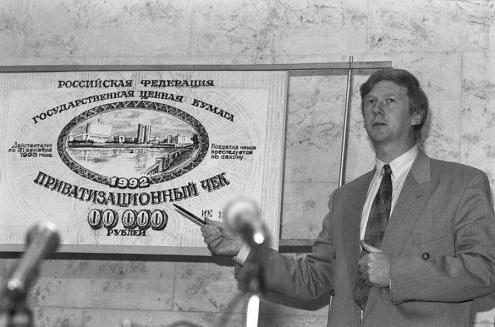
Criticism
All forms of privatization, including the voucher, were criticized both in the 90s and now. One of the most common claims is the charge of transferring property too quickly to private ownership. In fact, privatization in Russia took place without any preparation of state institutions and on a shaky legislative basis. Secondly, after the division of property, the federal government noticeably weakened. There was an erosion of public order, the growth of corruption began.Thirdly, the class of real owners did not appear. Almost all privatized property was transferred to the new owners through thieves and unscrupulous methods.
The viciousness of voucher mechanisms contributed to all this. The reformers sought to break with the communist past as quickly as possible, which led to sad consequences. Other critics simply blame the initiators of the economic transformation for crime and conspiracy with businessmen who have made a fortune out of nothing by deceiving ordinary citizens.
Was there an alternative privatization program? Critics often say that it should have happened slowly, as market institutions appeared. To honestly divide the Soviet legacy, it was proposed to extend state control over the privatized property. Back in recent years, the USSR discussed much the lease model with the right to buy out. This method could effectively replace the epic with vouchers, but it was not addressed.
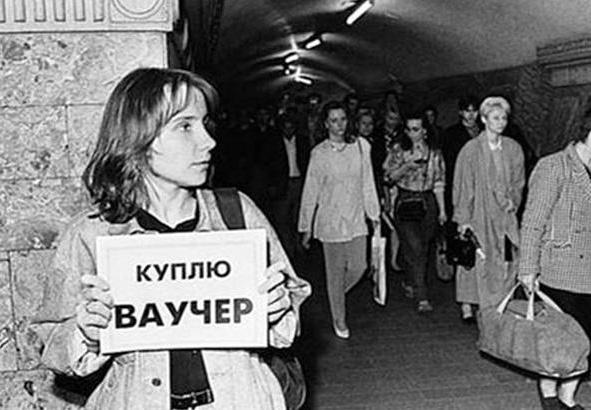
Protection of the selected course
The policies of Gaidar and Chubais have their own advocates. Talking about the impossibility of gradual reforms, they often appeal to the difficult situation that the economy found itself in when the voucher privatization began. Years of plans, five-year plans, budget imbalances, a bloated military-industrial complex in the Soviet era led to the fact that measures needed to be taken urgently. Without an instant restructuring of the economy, a country could face the danger of hunger, social tension, and in the worst case, civil war. That is why the reformers, who had real power at the end of 1991-1992, decided to use vouchers, although both Gaidar and Chubais were initially supporters of the plan for gradual privatization using the usual money.
Back in 1987, the USSR Law on State Enterprise was adopted. It was a landmark document. He recorded the actual independence of the labor collectives of factories (and in fact directors) from the state. Later this phenomenon was called "spontaneous privatization". This euphemism hid the transfer of property into the hands of those in whose hands it was at the time of adoption of the law. When the start of voucher privatization began, the power of the new Russia no longer had an impact on the lives of many enterprises that were formally still state owned, but in fact had already become the patrimony of the "red directors".
Another important law adopted back in Soviet times in 1988 was the Law on Cooperative Activities. This document suggested how to conveniently and legally pull away state property. The enterprises created cooperatives that began to engage in the most efficient activities of their plant, factory, etc. Their heads used the difference between their market and total state prices for their profit. The difference settled in the pocket of the director - the actual owner of the cooperative. Thus, the implementation of voucher privatization only consolidated those orders that already existed in the last Soviet years of economic chaos and devastation.








